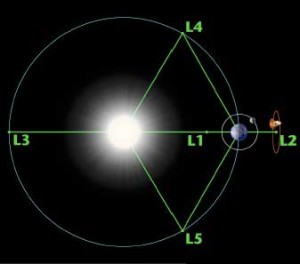Lagrange Points Earth Moon System
NASA defines these areas as spots where a small body – such as a spacecraft – can stay in a consistent orbit between two very large masses, such as two planets or a planet and a large moon.
When standing above Earth and looking around, it’s pretty straightforward to locate the five points. L1 is directly in front of Earth, between the Earth and the Sun. Extrapolating along the same line, L2 is behind Earth and L3 behind the Sun.
These three locations were first computed by Leonhard Euler around the 1770s, but as the name implies, the Lagrange points were actually named after French-Italian mathematician Joseph Lagrange.
A few years after Euler, Lagrange also found two other stable locations – known as L4 and L5 – at spots that are approximately 60 degrees from both the Earth and the Sun.
Space-faring nations have already sent several telescopes to Lagrange points near Earth, because they are far from interference from Earth’s atmosphere and heat. Only L4 and L5 are stable locations, but with a little extra fuel a telescope can happily sit at any of the Lagrange points for years.
Some of the more famous Lagrange residents include the Solar and Heliospheric Observatory (SOHO) – which keeps an eye on the Sun at L1 – and the James Webb Space Telescope, which will launch to L2 around 2018.
 NASA has said that it has no real use for the L3 Lagrange point near Earth, although it has been the source of some psuedo-scientific speculation throughout recent years. “It remains hidden behind the Sun at all times,” NASA wrote on its website, but added a tongue-in-cheek reference to what could be lurking there. “The idea of a hidden ‘Planet-X’ at the L3 point has been a popular topic in science fiction writing. The instability of Planet X’s orbit (on a time scale of 150 years) didn’t stop Hollywood from turning out classics like The Man From Planet X” the agency wrote.
NASA has said that it has no real use for the L3 Lagrange point near Earth, although it has been the source of some psuedo-scientific speculation throughout recent years. “It remains hidden behind the Sun at all times,” NASA wrote on its website, but added a tongue-in-cheek reference to what could be lurking there. “The idea of a hidden ‘Planet-X’ at the L3 point has been a popular topic in science fiction writing. The instability of Planet X’s orbit (on a time scale of 150 years) didn’t stop Hollywood from turning out classics like The Man From Planet X” the agency wrote.
While we most often think of the five Lagrange points located around the Earth, these points are possible between any celestial bodies that are massive enough. Jupiter, for example, has asteroids at its L4 and L5 points with the Sun. These are called Trojan asteroids.
German astronomer Max Wolf spotted the first of these asteroids in 1906. More than 100 years later, in 2012, NASA’s Wide-field Infrared Survey Explorer revealed that these bodies are mostly burgundy in colour, and reflect little sunlight.
